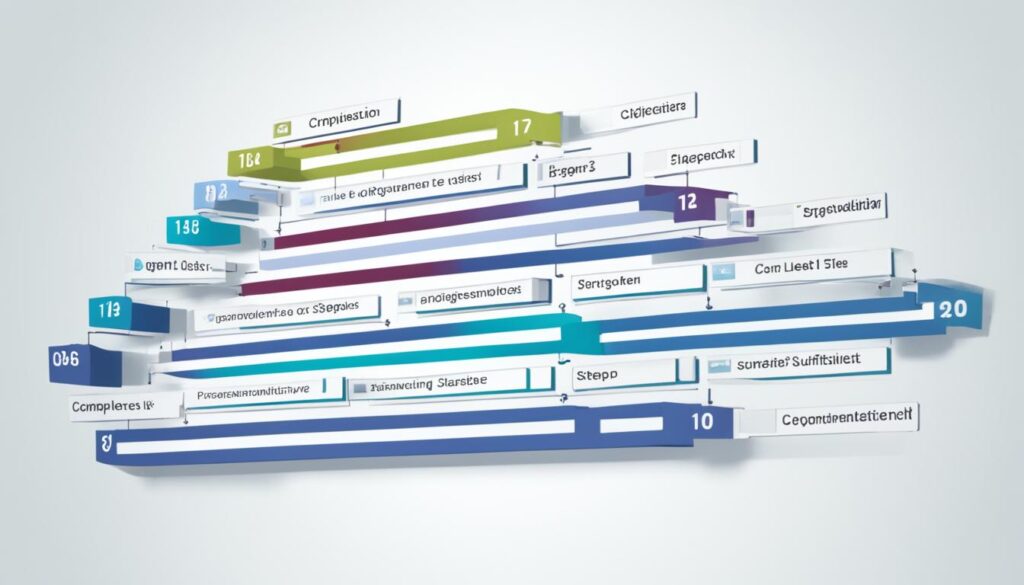The NIST SP800-37 framework provides a robust set of guidelines and practices for managing cybersecurity risk. While it may seem daunting for small and medium-sized enterprises (SMEs) to implement such a comprehensive framework, it is crucial for protecting their valuable assets and maintaining trust with customers. As a professional in the field of cybersecurity, I have firsthand experience with the challenges faced by SMEs and the practical strategies that can make the adoption of SP800-37 more manageable. In this article, we will explore step-by-step SP800-37 adoption tips specifically designed for SMEs, incorporating natural language processing (NLP) strategies and real-world insights to help you successfully implement the framework.
Here are some actionable insights and practical tips for SMEs looking to implement the SP800-37 framework:
- Start with a comprehensive assessment of your current cybersecurity posture to identify potential vulnerabilities and risks.
- Customize the framework to align with your organization’s specific needs and risks, focusing on the most critical areas first.
- Take advantage of the wealth of resources available on the NIST Framework website, such as the Quick Start Guide and Resource Repository, to gain a deeper understanding of the framework and its implementation.
- Incorporate NLP strategies to streamline the documentation and communication processes, making it easier for non-technical stakeholders to understand the cybersecurity initiatives.
- Develop a framework profile that reflects your organization’s desired cybersecurity outcomes and use it as a guide for assessing your current posture and tracking progress.
- Assess your implementation tier and strive for continuous improvement by adopting best practices and staying up-to-date with emerging technologies and threats.
- Consider the benefits of NIST compliance, even if it is not mandatory for your organization, such as improved data handling, competitive advantage, and eligibility for federal funding.
- Establish an effective IT risk-management framework tailored to the unique needs of SMEs, focusing on adaptability and cost-effectiveness.
- Encourage executive buy-in by leveraging the NIST recommendations and demonstrating the long-term benefits of effective cybersecurity risk management.
- Look to the future and stay updated on the latest developments in IT risk-management frameworks, exploring avenues for enhancing effectiveness and addressing industry-specific needs.
With these practical tips and strategies, SMEs can confidently embark on the journey of implementing the SP800-37 framework, ensuring the protection and resilience of their information systems. Stay tuned for the upcoming sections where we will delve deeper into the various aspects of the framework and provide actionable guidance to support your implementation efforts.
Getting Started with the Framework
If you’re ready to enhance your organization’s cybersecurity risk management, implementing the NIST Framework is a great place to start. Here are some valuable resources and guidance to help you get started on your journey:
1. Quick Start Guide
Begin by familiarizing yourself with the Quick Start Guide provided by the NIST Framework. This guide offers step-by-step implementation guidance and direction to help you effectively adopt the Framework. It provides a high-level overview of the key components and principles of the Framework, enabling you to understand its structure and align it with your organization’s needs.
2. NIST Framework Resource Repository
The NIST Framework Resource Repository is a comprehensive collection of approaches, methodologies, implementation guides, case studies, and other valuable materials. This repository serves as a one-stop-shop for resources that can assist you in implementing the Framework. It provides practical guidance and real-world examples to help you navigate the implementation process and address your unique cybersecurity risks.
3. Customization for Your Organization
Remember, the Framework is not a one-size-fits-all solution. It should be tailored to meet the specific needs and risks of your organization. Use the provided resources as a starting point and adapt them to fit your unique circumstances. Customization ensures that your implementation aligns with your organization’s goals, strategies, and risk tolerance.
By leveraging these resources, you’ll lay a solid foundation for implementing the NIST Framework. It’s important to approach the implementation process thoughtfully and involve key stakeholders from different departments. Collaboration and buy-in from everyone involved will enable a successful integration of the Framework into your organization’s cybersecurity risk management practices.
| Benefit | Description |
|---|---|
| Enhanced Cybersecurity | Implementing the NIST Framework improves your organization’s ability to manage cybersecurity risks effectively, enhancing overall security posture. |
| Alignment with Best Practices | The Framework incorporates industry best practices and established cybersecurity guidelines, ensuring your organization follows recommended standards. |
| Better Risk Management | By adopting the Framework, you create a structured approach to identify, assess, and mitigate cybersecurity risks, enabling better risk management. |
| Regulatory Compliance | Implementing the NIST Framework demonstrates your commitment to cybersecurity, increasing compliance with regulatory requirements and industry standards. |
When it comes to implementing the NIST Framework, remember that it’s an ongoing process. Continuously review and update your cybersecurity practices to stay aligned with evolving threats and best practices. By doing so, you’ll foster a culture of security and resilience within your organization, safeguarding critical assets and ensuring a robust cybersecurity posture.
Framework Requirements for SMEs
While the use of the Framework is voluntary for most organizations, some are required to use it. Executive Order 13800 made the Framework mandatory for U.S. federal government agencies, and certain federal, state, and foreign governments, as well as insurance organizations, have also made it mandatory for specific sectors.
NIST does not offer certification for compliance with the Framework, but organizations may be required to provide compliance documentation when doing business with the government.
Compliance with the Framework is crucial for organizations operating in regulated sectors or seeking government contracts. It demonstrates a commitment to robust cybersecurity practices and risk management. By aligning with the NIST Framework, SMEs can:
- Enhance their overall cybersecurity posture
- Protect sensitive data and customer information
- Meet regulatory requirements and industry standards
- Improve their chances of winning government contracts
- Boost customer confidence and strengthen business relationships
Adhering to the Framework not only ensures compliance but also provides a comprehensive approach to cybersecurity that can adapt to evolving threats and challenges. SMEs can leverage the Framework to assess their current cybersecurity practices, identify areas for improvement, and establish a roadmap for continuous enhancement.
Framework Core Components
The Framework Core is an essential part of the NIST Framework that forms the foundation for effective cybersecurity risk management. It comprises several key components that work together to provide a comprehensive approach to addressing cybersecurity risks.
Functions of the Framework
The Framework Core is organized into five Functions that represent various aspects of a cybersecurity risk management lifecycle:
- Identify: This function involves developing an understanding of the organization’s cybersecurity risks, including the identification of critical assets and associated vulnerabilities.
- Protect: The Protect function outlines the measures and safeguards organizations should implement to mitigate cybersecurity risks, ensuring the security and resilience of critical assets.
- Detect: This function focuses on the continuous monitoring and detection of cybersecurity events. It enables organizations to identify potential cybersecurity incidents promptly.
- Respond: In the event of a cybersecurity incident, the Respond function guides organizations in responding effectively by implementing an incident response plan, minimizing the impact, and restoring normal operations.
- Recover: The Recover function emphasizes the importance of planning and strategies to restore operations and services after a cybersecurity incident, ensuring business continuity.
Core Categories and Subcategories
Within each Function, the Framework Core further organizes cybersecurity outcomes into Categories and Subcategories. These Categories represent groups of cybersecurity activities or desired outcomes, while Subcategories define specific actions or practices to achieve the intended outcomes. The categorization allows organizations to identify and prioritize areas of improvement based on their unique risk profiles.
Informative References
The Framework Core provides Informative References, which include established standards, guidelines, and industry best practices that align with each Subcategory. These Informative References offer organizations valuable resources that can be leveraged to implement effective cybersecurity practices.
| Core Function | Core Category | Core Subcategory | Informative References |
|---|---|---|---|
| Identify | Asset Management (ID.AM) | Physical devices and systems within the organization (ID.AM-1) | SP 800-53, NISTIR 7621 |
| Software and applications within the organization (ID.AM-2) | CIS Controls, ISO/IEC 27002 | ||
| Governance (ID.GV) | Asset management strategy and plans (ID.GV-1) | COBIT, ISO/IEC 27001 | |
| Organization-wide cybersecurity policy (ID.GV-2) | SP 800-53, NISTIR 7693 |
Table: Example of Core Function, Category, Subcategory, and Informative References
Framework Profiles
Framework Profiles play a crucial role in cybersecurity risk management, allowing organizations to tailor their approach according to their specific needs and goals. Profiles represent the cybersecurity outcomes selected from the Framework’s Categories and Subcategories, enabling organizations to assess their current cybersecurity posture and identify areas for improvement.
Developing a Profile involves carefully analyzing each Category and Subcategory within the Framework to determine the desired outcomes for an organization’s cybersecurity. By aligning these outcomes with their objectives and priorities, organizations can create a Profile that best suits their unique requirements.
This process allows organizations to compare their Current Profile, reflecting their existing cybersecurity measures, with their Target Profile, representing their desired state of cybersecurity. This comparison enables organizations to track their progress and make informed decisions on prioritizing their efforts for improved cybersecurity risk management.
Self-assessment with Profiles allows organizations to evaluate their cybersecurity capabilities against the selected outcomes within their Profile. This enables organizations to identify any gaps or weaknesses in their current cybersecurity posture and take proactive measures to address them.
Profiles also serve as a crucial communication tool within and between organizations. By sharing Profiles, stakeholders can effectively communicate their cybersecurity goals, strategies, and progress, fostering collaboration and alignment in cybersecurity risk management efforts.
Framework Profiles Benefits
Implementing Framework Profiles offers several benefits to organizations:
- Customization: Profiles allow organizations to tailor their cybersecurity approach according to their specific needs and risks.
- Targeted Improvement: By comparing Current and Target Profiles, organizations can identify the areas that require immediate attention and allocate resources accordingly.
- Enhanced Risk Management: Profiles enable organizations to focus on the key cybersecurity outcomes that align with their objectives, ensuring a strategic and effective approach to risk management.
- Communication and Collaboration: Sharing Profiles facilitates clear and concise communication about cybersecurity goals, progress, and strategies, enhancing collaboration among stakeholders.
To better understand the concept of Framework Profiles, the following table illustrates an example of developing a Profile:
| Framework Category | Framework Subcategory | Current Outcome | Target Outcome |
|---|---|---|---|
| Identify | Asset Management | Asset inventory documentation is not comprehensive. | Complete and up-to-date asset inventory documentation. |
| Governance | Security policies are not regularly reviewed and updated. | Establish regular review and update process for security policies. | |
| Protect | Data Security | Data classification and encryption practices are inconsistent. | Consistent data classification and encryption practices. |
| Awareness and Training | Limited employee awareness and training on cybersecurity best practices. | Regular employee awareness and training on cybersecurity best practices. |
By developing a Profile and monitoring the progress towards the Target Profile, organizations can strengthen their cybersecurity posture and effectively manage their cybersecurity risks.
With Framework Profiles, organizations can take a proactive and targeted approach to cybersecurity risk management, ensuring that their efforts are aligned with their specific needs and objectives. By continuously assessing and improving their cybersecurity posture, organizations can enhance their overall resilience to cybersecurity threats.
Framework Implementation Tiers

Implementing the Framework requires organizations to assess their current cybersecurity risk management practices and determine their level of implementation. The Framework Implementation Tiers provide valuable context in understanding an organization’s progress and maturity in implementing the Framework.
The Tiers range from Partial Implementation to Adaptive, representing various levels of cybersecurity risk management practices. Each Tier is characterized by its unique approach to risk management and the organization’s ability to adapt and respond to evolving threats.
Assessing the Implementation Tiers involves evaluating the organization’s current practices and capabilities against the desired outcomes outlined in the Framework. This assessment allows organizations to identify gaps and determine areas that require improvement.
Adoption of the Framework starts with organizations implementing the practices and controls described within each Tier. By aligning their cybersecurity efforts with the Framework, organizations can establish a solid foundation for managing their cybersecurity risks effectively.
Continuous improvement is a core principle of the Framework. Organizations should strive to continuously monitor, assess, and update their cybersecurity practices to address emerging threats and vulnerabilities. By staying proactive and adaptable, organizations can enhance their cybersecurity posture and mitigate risks.
| Tier | Description |
|---|---|
| Partial Implementation | Organizations at this Tier have limited awareness of cybersecurity risks and have ad hoc practices in place. They prioritize cybersecurity on an as-needed basis. |
| Risk-Informed | Organizations at this Tier start to develop an understanding of their cybersecurity risks and implement risk management practices. They consider risk when making decisions. |
| Repeatable | Organizations at this Tier have established basic cybersecurity risk management practices and enforce them consistently. They develop standardized processes and procedures. |
| Adaptive | Organizations at this Tier are highly adaptable and responsive to cybersecurity risks. They continuously evaluate and improve their cybersecurity practices based on changing threats and vulnerabilities. |
NIST Compliance for SMEs
While NIST compliance is not mandatory for most SMEs, there are certain cases where compliance may be required. Private-sector businesses that work with government agencies or participate in the federal supply chain may need to adhere to NIST standards. Compliance with NIST standards brings various benefits to SMEs, including:
- Improved data handling and security protocols
- A competitive advantage in government contract bidding
- Protection from cyberattacks and data breaches
- Qualification for federal funding opportunities
In many cases, NIST compliance is self-certified, meaning that SMEs can evaluate their own adherence to the standards. However, third-party certification is also available for those who prefer an external validation of their compliance efforts.
Adhering to NIST compliance requirements helps SMEs establish robust cybersecurity practices, ensuring the protection of sensitive data and mitigating potential risks. The self-certification process allows SMEs to demonstrate their commitment to cybersecurity best practices, reinforcing trust and credibility with clients, partners, and government entities.
By voluntarily embracing NIST compliance requirements, SMEs can enhance their cybersecurity posture, gain a competitive advantage, and contribute to the overall security of the digital ecosystem.
Benefits of NIST Compliance for SMEs
NIST compliance offers a range of benefits specifically tailored for SMEs:
| Benefit | Description |
|---|---|
| Improved Data Handling | Implementing NIST compliance requirements helps SMEs establish secure data handling practices, protecting sensitive information from unauthorized access. |
| Competitive Advantage | NIST compliance enhances SMEs’ eligibility for government contracts, providing a competitive edge in the bidding process. |
| Cyberattack Protection | Complying with NIST standards helps SMEs fortify their cybersecurity defenses, reducing the risk of cyberattacks and data breaches. |
| Federal Funding Qualification | By meeting NIST compliance requirements, SMEs can access federal funding opportunities, driving financial growth and innovation. |
| Client and Partner Confidence | NIST compliance signifies SMEs’ commitment to cybersecurity best practices, enhancing trust and credibility with clients and partners. |
Implementing NIST compliance requirements is a proactive measure that can safeguard the interests and future growth of SMEs in an increasingly interconnected digital landscape. Self-certification allows SMEs to take control of their cybersecurity practices, while third-party certification further validates their commitment to meeting industry standards.
NIST Compliance Benefits for SMEs

NIST compliance offers several benefits for SMEs, providing them with valuable advantages in terms of cybersecurity initiatives and long-term risk management. By adopting the NIST Framework, SMEs can gain executive buy-in for their cybersecurity efforts, ensuring that senior leaders prioritize and support these initiatives.
One of the key advantages of NIST compliance is that it provides a common language that non-technical stakeholders can easily understand. This facilitates meaningful conversations about cybersecurity risks and allows SMEs to effectively communicate the importance of implementing necessary security measures.
Additionally, the NIST Framework offers a comprehensive approach to managing cybersecurity risks. It provides SMEs with a structured framework that covers various aspects of cybersecurity, including risk assessment, incident response, and recovery. By following the NIST guidelines, SMEs can establish robust and systematic cybersecurity practices that protect their sensitive information and critical assets.
Another significant benefit of NIST compliance is that it helps SMEs remain compliant despite evolving regulations. Cybersecurity requirements and regulations are constantly changing, which can pose challenges for SMEs in terms of keeping up with compliance. However, by adhering to the NIST Framework, SMEs can stay ahead of the regulatory curve and adapt their cybersecurity practices accordingly.
NIST compliance can also enhance the reputation and credibility of SMEs. Even if SMEs are not contractually obliged to comply with NIST standards, adopting these best practices can build trust and confidence with clients, partners, and other stakeholders. Demonstrating a commitment to cybersecurity and following recognized industry standards can give SMEs a competitive edge and differentiate them in the marketplace.
Ultimately, NIST compliance supports long-term cybersecurity risk management for SMEs. By implementing the NIST Framework, SMEs can establish a strong foundation for managing and mitigating cybersecurity risks, safeguarding their operations, and protecting their valuable assets. This proactive approach to cybersecurity can help SMEs avoid costly data breaches, reputational damage, and regulatory penalties.
Establishing an Effective IT Risk-Management Framework for SMEs
SMEs often face significant challenges when it comes to implementing security standards. Limited resources and high costs make it difficult for these businesses to adopt comprehensive IT risk-management frameworks. Existing frameworks may not adequately address the unique needs of SMEs, leaving them vulnerable to cybersecurity threats.
However, it is essential for SMEs to establish an effective IT risk-management framework to safeguard their critical data and systems. This requires a solution that is both adaptable and cost-effective, capable of addressing the evolving technological landscape while considering the resource constraints of small and medium-sized enterprises.
To overcome these challenges, SMEs can benefit from IT risk-management frameworks that provide tailored guidance and emphasize cost-effectiveness and innovation in risk management. By adopting an approach that aligns with their size and resources, SMEs can implement practical and sustainable risk-management practices.
Challenges for SMEs in Implementing Security Standards
SMEs face unique challenges when it comes to implementing security standards:
- Budgetary Constraints: Limited financial resources often make it difficult for SMEs to invest in comprehensive security measures.
- Lack of Expertise: SMEs may not have dedicated cybersecurity professionals who can effectively implement and manage security standards.
- Resource Constraints: Small teams and limited staff make it challenging to allocate resources for security and risk management.
Adaptability and Cost-Effectiveness in Risk Management
An effective IT risk-management framework for SMEs must prioritize adaptability and cost-effectiveness:
- Scalability: The framework should be scalable, allowing SMEs to adjust its implementation as their business grows.
- Flexibility: The framework should accommodate technological advancements and evolving threats, ensuring SMEs stay resilient.
- Affordability: Cost-effective solutions are vital for SMEs, ensuring they can manage risk without straining their limited financial resources.
- Innovation: Embracing innovative approaches can help SMEs achieve effective risk management while optimizing costs.
To illustrate the challenges and the need for an effective IT risk-management framework, we present the following table:
| Challenges | Solutions |
|---|---|
| Budgetary Constraints | Implement cost-effective security measures |
| Lack of Expertise | Invest in training or outsourcing to cybersecurity experts |
| Resource Constraints | Optimize resource allocation and prioritize risk management |
By addressing these challenges and implementing an effective IT risk-management framework, SMEs can enhance their overall cybersecurity posture and protect their valuable assets from an ever-evolving threat landscape.
Future Directions for IT Risk-Management Frameworks for SMEs
The effectiveness and adaptability of IT risk-management frameworks for SMEs play a crucial role in ensuring the long-term security and resilience of their information systems. As technology continues to evolve, the need for ongoing research and development becomes more apparent. We recommend focusing on enhancing the customization and scalability of frameworks for SMEs, addressing specific industry needs, and integrating emerging technologies into risk-management practices.
Improving the customization and scalability of frameworks for SMEs is essential in tailoring risk-management solutions to meet their unique requirements. This can involve developing modular frameworks that allow SMEs to select and implement only the components that are most relevant to their operations. Scalability ensures that the frameworks can adapt as the SME grows, accommodating increased data volumes and expanding technology infrastructures.
Addressing specific industry needs is another critical aspect to consider in the future development of IT risk-management frameworks. Different industries face varying cybersecurity challenges, and frameworks must be designed to address these specific risks. This requires collaboration with industry experts and stakeholders to identify and incorporate industry-specific best practices and compliance requirements into the frameworks.
The integration of emerging technologies into risk-management practices is also a key area for future research and development. Technologies like artificial intelligence (AI), machine learning, and advanced analytics can provide SMEs with more efficient and effective risk assessment and mitigation capabilities. Finding ways to incorporate these technologies into frameworks will enable SMEs to stay ahead of emerging threats and enhance their overall cybersecurity posture.
In conclusion, the future of IT risk-management frameworks for SMEs lies in continuous enhancement and adaptability. By focusing on improving customization and scalability, addressing specific industry needs, and integrating emerging technologies, we can develop frameworks that effectively mitigate risks, support SME growth, and ensure the long-term security of their information systems.







